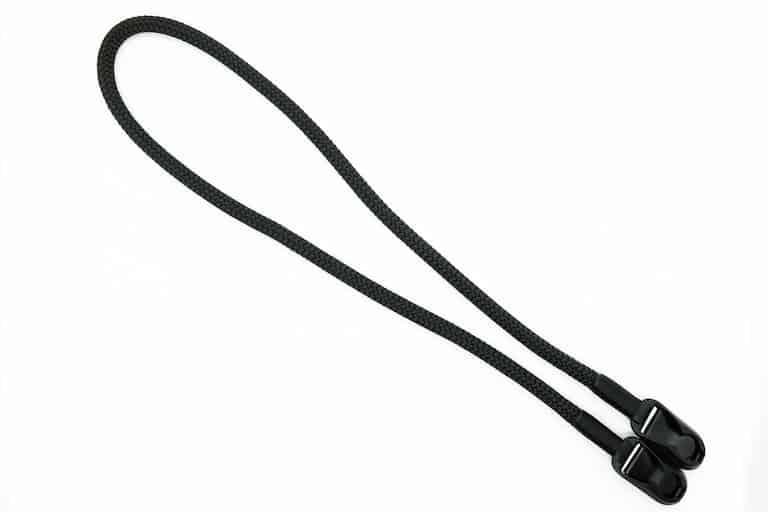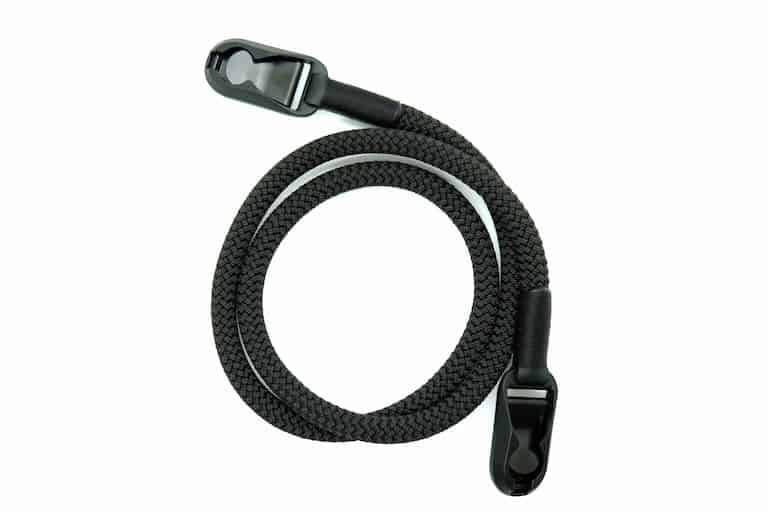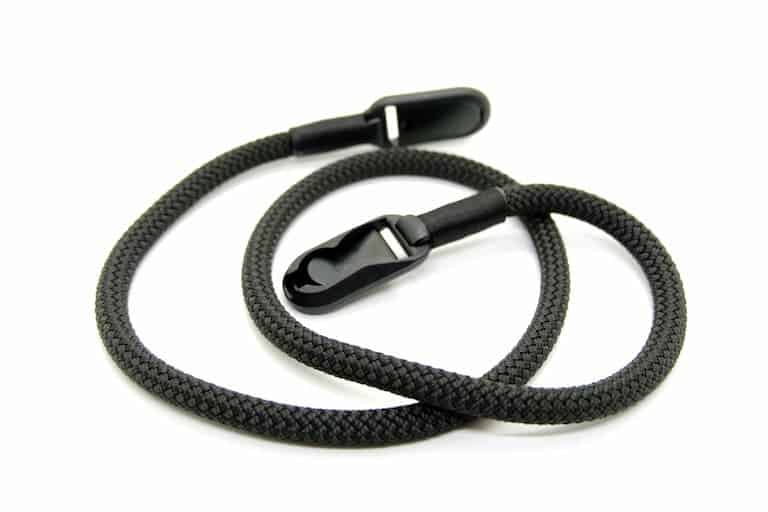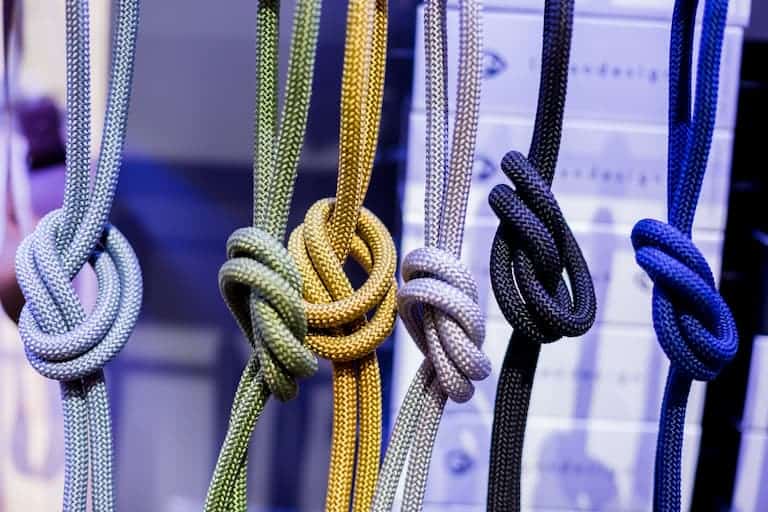Seasoned photographers understand the importance of comfort and stability during a photoshoot, especially if you’ll be on your feet for long hours. Camera straps are one essential element that every photographer should consider before hitting the road.
Rope camera straps are just as comfortable, if not more comfortable than their flat canvas, polyester, or leather counterparts. Their built-in cushioning and roll-free, tangle-free design help to make rope straps more comfortable for long photoshoots.
In the rest of this article, we’ll explore the comfortability of rope camera straps, the pros and cons of using silk or nylon straps, and how to choose the best camera strap for you.
Table of Contents
How Comfortable Are Rope Camera Straps?
Most photographers find rope camera straps to be very comfortable. Rope camera straps are made from smooth silk or nylon. The thick, soft rope keeps the strap from digging into your neck or shoulder, especially when you have a large or heavy camera.
Rope straps dig into your neck and shoulders less than other straps because they are typically round or have rounded edges. The rounded design also prevents the strap from becoming twisted, rolled, or tangled.
The material in rope camera straps is also purported to be more comfortable than leather, canvas, or other materials because it slides more easily on the skin and is less prone to collecting sweat.

How to Make Rope Camera Straps More Comfortable
Silk or nylon rope camera straps are already known for being quite comfortable, but is there a way to make them more comfortable?
Maybe you’re hesitant about purchasing a rope camera strap, or you already own a rope strap but you’re wishing to make it more comfortable. Here are some tips for making your strap feel like a second skin:
Break It In
Much like a new pair of leather boots, a brand new camera strap can feel stiff. If your strap is digging into your neck, shoulders, or wrist, you may need to break it in.
After removing the strap from the camera, start by gently bending, folding, and twisting the rope to soften up the material. Silk and nylon rope are incredibly durable, but be gentle with your camera strap. You would want to avoid fraying or unraveling the rope.
Wear It Out
After softening the rope, begin wearing the camera strap around the house for a few hours at a time. You do not have to attach your camera to the strap while you are at home, but adding some weight to the hook ends will help your camera strap to break in faster.
If you’re not shy, you can even wear the camera strap like an accessory while you’re out on the town. After a few days or weeks of keeping the strap on your body, you should find that it fits much more comfortably, and you’ll hardly notice it’s there!

Shorten the Strap
While it may seem a little counterintuitive, wearing the strap shorter will bring the camera closer to your body and help to distribute its weight. Much like tightening the straps on a backpack, tightening the straps on your camera will keep it from swinging, tugging, and chafing your skin.
Add Padding
If all else fails, you can add padding to the rope camera strap, such as this example:
Memory Foam Shoulder Strap Pad on Amazon. The pad will velcro right over your rope camera strap, helping to distribute the weight of the camera and pad your neck or shoulder.
Why Choose Silk or Nylon Rope Camera Straps?
The purpose of a camera strap is to help make shooting more comfortable and to prevent you from dropping your camera. As you may already know, professional cameras can be very expensive!
Just about any strap will serve the basic purpose of safety, but some straps are stronger or more comfortable than others.
Both silk and nylon rope camera straps are slick, durable, and comfortable materials. They are an excellent choice for photographers who are always on the go, climbing, moving, and hiking because they are less likely to twist, dig, or chafe the skin than other straps.
Rope camera straps also lend themselves to a stylish vintage aesthetic coveted by many camera fanatics.

Here are some pros and cons of using silk or nylon rope camera straps:
Pros
- Comfortable
- Durable
- Affordable
- Chafe-resistant
- Sweat-resistant
- Lots of designs and colors
Cons
- Length is not always adjustable
- Less fancy appearance
Top Rated Rope Camera Straps
-
 $14.99Buy Now
$14.99Buy NowThis camera strap features a sturdy, vintage design with lots of colors to choose from, and fits comfortably over your neck or shoulder. Match the strap color to your camera for a sleek, minimal style, or go bold with one of the bright patterns! This camera strap is compatible with all round-hole cameras and cameras with small eyelets, including retro and micro single cameras.
We earn a commission if you make a purchase, at no additional cost to you.
03/05/2024 05:41 pm GMT -
 $11.97Buy Now
$11.97Buy NowFor photographers on-the-go, a wrist strap can sometimes provide more comfort and ease of access for action shots. If you prefer to wear your camera strap on your wrist, try this highly-rated VKO rope strap. This strap is 13.4 in (34 cm) long, tightens to fit your wrist, and comes in five colors. It’s compatible with most Fujifilm, Sony, Nikon, and Canon cameras, and more up to medium size DSLR. The climbing rope-inspired design will fit in perfectly for any of your outdoor adventures.
We earn a commission if you make a purchase, at no additional cost to you.
03/06/2024 01:05 pm GMT -
 Buy Now
Buy NowWho said rope can’t be luxurious? This rope camera strap on Amazon.com is the priciest option on this list, but for a good reason. This strap is 47 in (120 cm) and features finished leather ends, branded pouch for portability, and built-in tension relief. It’s recommended for cross-body carrying and includes an extra pair of rings for the perfect camera fit.
We earn a commission if you make a purchase, at no additional cost to you.
Choosing the Best Camera Strap for You
When it comes to choosing an all-around daily camera strap, there are a few things to consider: your photography style, how you will wear your camera, your budget, and your personal style.

Consider Your Photography Style
Understanding how you like to take your photos may help you determine which kind of camera strap is best for you. When thinking about your photography style, you will want to consider the locations and events where you frequently shoot and the motions you most often make.
Locations
Do you usually take photos in a studio? Or out in nature? How is the weather where you work? If you mostly shoot outdoors, you’ll want to consider the elements, like rain, humidity, and heat.
For example, a leather or canvas strap may not be the best choice for a hot, humid environment because they can cause you to chafe and sweat, and they may collect odors. But if you work indoors, you will have a wider selection of appropriate camera straps.
Events
Do you photograph weddings or engagements? How about sporting events or commercial products?
If you photograph often at a particular type of event, you may want to consider a strap that is congruent with the event. For example, a brightly colored neoprene strap would not be a good choice for a black-tie celebration, but it would likely be appropriate for a sporting event.
Leather is undoubtedly the classiest option for weddings and other formal situations, especially if you care about looking your best for clients. Canvas and rope camera straps are excellent for capturing a vintage vibe.
Motions and Angles
The third aspect to consider about your photography style is how you move your body. Do you like to shoot at a rugged upward or downward angle? Are you often climbing, crouching, or laying down? Do you need to be able to use both hands to position yourself around your subject?
If you tend to move a lot during photo shoots, you’ll want to choose a strap that limits rubbing and chafing on your skin, such as a rope camera strap.
The strap will also need to be durable and sturdy enough to hold your camera without any worry about it dropping, bouncing, or yanking at your neck and shoulders.
Consider How You Wear Your Camera
How you like to wear your camera will also play a part in the type of strap you should choose. Depending on where you wear your camera strap, you’ll want to choose the most comfortable and durable option possible.
Neck Strap
Wearing the strap around your neck will enable you to easily access the camera with both hands and drop it down again when not in use.
The downsides of wearing the camera at your neck are that you’ll have to stabilize your shot every time, and if you are doing a lot of moving, bouncing, or crouching, the heavy camera will pull on your neck and back.
Neck straps can be made from nylon or silk rope, polyester, neoprene, canvas, or leather. While they can support large cameras, they’re best for small to medium sized cameras without too much weight.
Shoulder Strap
Shoulder straps can be made from nylon or silk rope, polyester, neoprene, canvas, or leather.
Wearing the strap across your shoulder will allow you to very quickly swing the camera up from your hip with one hand. This method is highly recommended.
Most professional photographers choose to wear the camera strap on their shoulders, as the camera is less likely to be damaged and it saves the wearer from a lot of neck pain. It is perfect for bulky, heavy cameras.
Wrist Strap
The wrist strap is the lightest and perhaps most comfortable option. Wearing the camera strap on your wrist ensures that if you happen to drop your camera mid-shoot, the camera won’t fall and also won’t yank at your neck or shoulder.
The downside to a wrist strap, of course, is that you’ll need to keep it on your wrist to protect the camera. If you perform a lot of movements during your photoshoots, you’ll want to be able to rest your camera and have both hands free.
Wrist straps are usually made from thinner, softer materials like rope and polyester. They’re most appropriate for smaller handheld cameras, but can also be used in addition to neck and shoulder straps for extra security.
Consider Your Budget
When choosing your camera strap, you’ll want to think about how to get the best value for your buck, while also providing the best protection for your camera.
A pricier camera may warrant a pricier camera strap. Not only will a quality strap protect your expensive camera from falling, but a fancy strap will elevate the appearance of your overall look. A cheap-looking strap may distract from your professionality.
With that being said, there’s no need to break the bank over a camera strap.
At the end of the day, the quality of your photographs will matter much more than the strap you wear. If you are a beginner photographer, invest in a high-quality camera strap within your budget.
Leather is typically the most expensive camera strap material. For other materials like rope, canvas, polyester, and neoprene, the quality and construction of the strap will affect the price more than the material.
Consider Both Comfort and Style
Your camera strap presents a special opportunity to express your personal style to those around you. The strap can be as plain or as decorative as you desire, helping you to blend in seamlessly or stand out from the crowd.
While you may love the aesthetic of a leather camera strap, you won’t enjoy wearing it for photoshoots if it is too uncomfortable. When choosing a camera strap, it is important to be true to yourself and your personal brand without sacrificing comfort.
Final Thoughts
Rope camera straps are an all-around reliable and comfortable option for any photographer, no matter if you’re an amateur, hobbyist, or seasoned professional.
Choosing a camera strap may seem complicated, but remember that every strap serves the same basic purposes: protecting your camera and enabling you to take your best shots.
Take time to weigh your options, and invest in a high-quality camera strap that won’t let you (or your camera) down.





